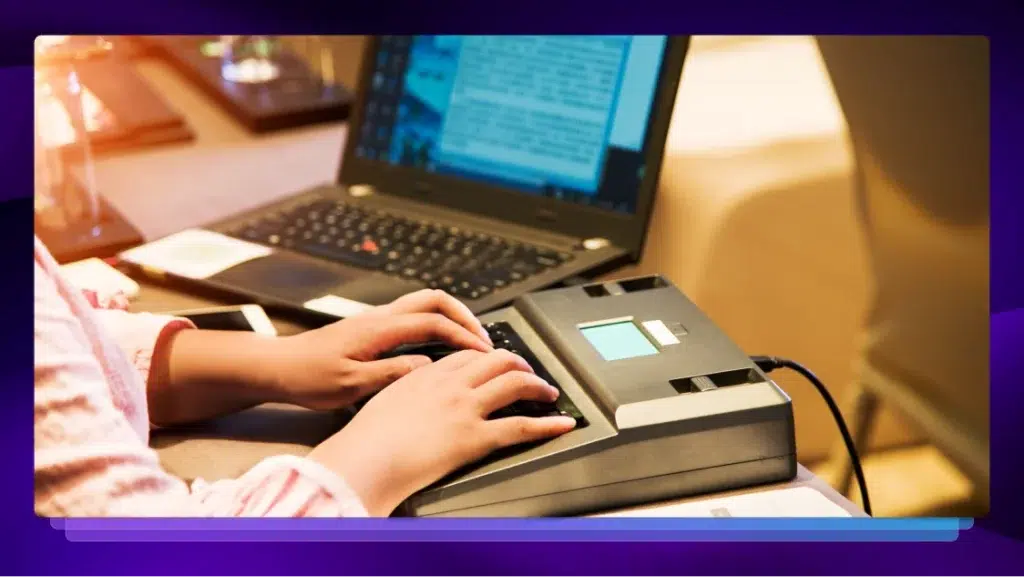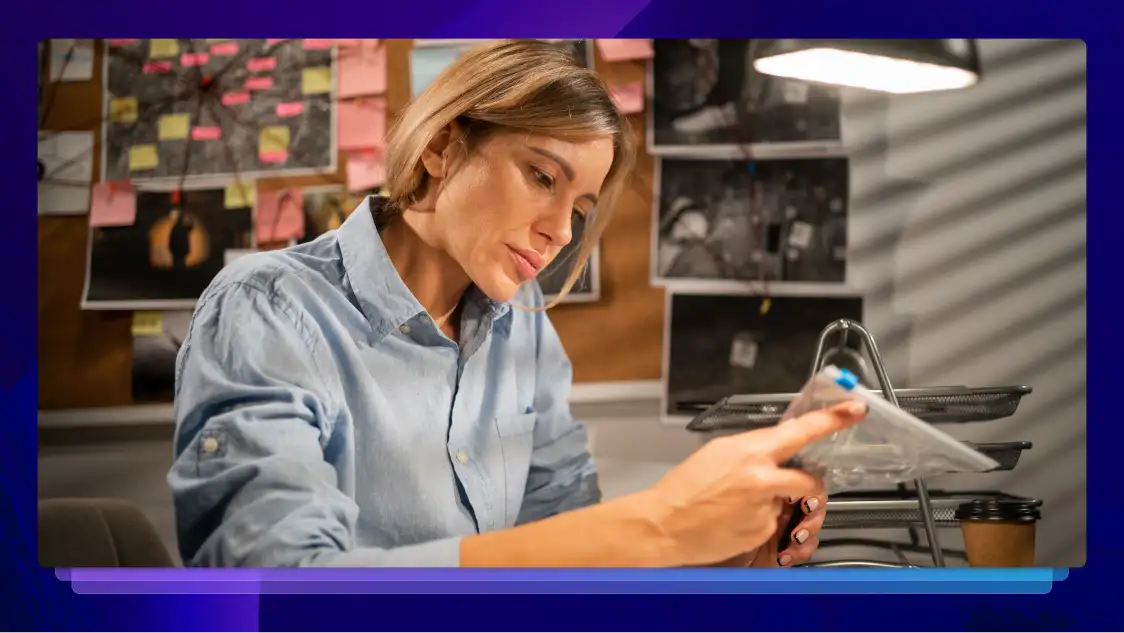What Is a Stenographer? How It Works & How To Become One
Discover the world of stenography: from its history to modern tools, learn how to become a stenographer and explore its role in transcription.

A stenographer is a person who specializes in transcribing spoken words into text using a stenotype machine or shorthand writing techniques — they typically work in courtrooms, where they record verbatim transcripts of legal proceedings.
Stenographers spend their time in fast-paced environments, using a range of specialized tools to write down everything that is being said. Stenographers also work in business and corporate environments, conferences, or television captioning.
The transcriptions that stenographers create are often used as official records or for reference purposes, so they must have excellent typing skills, attention to detail, and the ability to capture speech accurately and efficiently. Let’s dive into more about stenography, discover common stenography tools, and how you can become one.
History of Stenography
The history of stenography goes back thousands of years, to the creation of shorthand writing — this type of writing first emerged in ancient civilizations like Egypt, Greece, and Rome.
The development of modern stenography, however, can be attributed to the efforts of Timothy Bright, who published the first shorthand system in 1588. Over the next few centuries, various shorthand systems would be developed and refined, including those by Thomas Shelton and Isaac Pitman, which gained widespread popularity in the 19th century.
Stenography experienced a boom in the 20th century with the invention of the stenotype machine, which allowed for even faster transcription.
How It’s Done Today
Modern stenographers primarily use evolved versions of these stenotype machines, which have taken the form of compact keyboards specifically designed for capturing spoken language in real-time. Despite technological advancements, the core principles of stenography remain unchanged, emphasizing accuracy, speed, and proficiency in capturing spoken language.
The Future of Stenography
Stenography, like many other fields of work, is expected to undergo even more transformation, fueled by things like artificial intelligence (AI) and natural language processing (NLP).
- As Steno AI becomes more sophisticated, while also becoming more accessible, we can anticipate stenography evolving towards even greater levels of automation. Advanced and automatic speech recognition combined with machine learning can bring about unprecedented accuracy and speed, perhaps even surpassing human capabilities.
- The integration of real-time translation features can achieve cross-language communication, breaking down linguistic barriers on a global scale.
- Wearable devices and augmented reality tools will revolutionize how stenographers capture and process speech, offering seamless integration into various settings.
Even with all of these developments, there’s no need to worry — AI and other evolving technologies won’t replace stenographers. Human elements involved in stenography, such as critical thinking and contextual understanding, will remain invaluable for generations to come.
Stenography Tools: What They Are and How They’re Used
Apart from the soft skills needed by stenographers, there are a variety of physical and software-based stenography tools used to make the process of recording spoken words in written form faster and easier.
Stenotype Machines
Stenotype or stenograph machines allow stenographers to press multiple keys simultaneously to represent entire words, phrases, or sounds, enabling them to transcribe speech at incredibly fast speeds.
The shorthand strokes entered on a stenotype machine run through a specialized software known as computer-aided transcription (CAT), and translated into English text. This software converts shorthand strokes into readable text, and also edits, formats, and produces the final transcripts.
Voice Recognition Technology
Some stenographers supplement the use of a stenotype machine with voice recognition technology to enhance their transcription capabilities even more (though this is different than the stenomask that voice writers use).
These voice recognition systems can integrate directly with stenograph machines, or function as independent systems. They do the work of converting spoken language into text, meaning stenographers can focus more of their time on editing and formatting rather than manual transcript creation.
While this technology has significantly streamlined the transcription process, voice recognition does have its challenges, as varying dialects, accents, and background noise can interfere with the technology’s abilities.
Shorthand Notebooks and Stenographic Paper
While stenotype machines and voice recognition technology offer digital solutions, many stenographers still rely on traditional shorthand techniques for certain situations, such as taking notes during meetings, interviews, or other settings where a stenotype machine may be distracting or impractical.
Shorthand is a system of rapid writing that uses symbols or abbreviations to represent words or phrases. Shorthand notebooks and pens are portable, affordable, and offer stenographers flexibility in capturing spoken word in various contexts.
How to Become a Stenographer
Choosing a stenography career can offer you the opportunity to immerse yourself in the world of transcription, as well as participate in important conversations in legal and business settings.
Whether capturing courtroom proceedings, transcribing business meetings, or providing closed captioning services, stenographers play a pivotal role in transforming spoken words into written records with accuracy and efficiency. Let’s take a look at what it takes to become a stenographer.
Education and Training
To become a stenographer, you will typically need to complete a postsecondary stenography program. These programs are available at community colleges, technical schools, or stenography institutes.
Some stenographers may also pursue certification through organizations such as the National Court Reporters Association (NCRA) or the American Association of Electronic Reporters and Transcribers (AAERT) to further demonstrate their expertise and qualifications in the field.
As with most careers, while formal education is essential, getting even more experience through internships or on-the-job training can be helpful for stenographers in training to develop their skills and adapt to real-world scenarios.
Skills Needed
In addition to certification and education, continued practice and refinement of “soft” skills are essential. These skills include:
- Typing speed and accuracy: The ability to type quickly while maintaining accuracy is crucial for capturing spoken language effectively.
- Shorthand writing techniques: Knowledge of shorthand symbols, abbreviations, and techniques allows stenographers to transcribe speech quickly.
- Attention to detail: Stenographers must have keen attention to detail to ensure the accuracy of their transcripts.
- Listening skills: In environments like courtrooms and business meetings, stenographers must be able to concentrate for extended periods of time, even when there is background noise.
- Digital literacy: Aside from stenotype machines and transcription software, stenographers must be familiar enough with technology to adapt to new tools and software.
- Time management: Stenographers often work under tight deadlines and must be able to manage their time effectively to meet transcription deadlines and client expectations.
Average Salary
The average salary for a stenographer is $55,808 per year, according to Indeed. However, stenographer salaries may vary based on several factors: your years of experience, the specific type of speech you transcribe as a stenographer, your location, and many others.
What Is the Difference Between Court Reporting, Stenography, and Transcription?
While stenography, court reporting, and transcription are all ways of converting spoken language into written form in legal settings, they differ in their approach and techniques:
- Court reporting specifically refers to the process of turning spoken words into text as conversations take place during legal proceedings, trials, depositions, hearings, and more. Court reporting is a specialized form of stenography focused on legal proceedings. Learn how to become a court reporter on our blog.
- Stenography is a broader term that encompasses the practice of transforming spoken language into text using shorthand writing techniques or stenotype machines. Outside of legal proceedings, stenographers also work in other settings such as business meetings, conferences, or television captioning.
- Transcription involves listening to pre-recorded audio or video and transcribing it using a computer or specialized software. Transcriptionists work with a wide range of materials, including interviews, dictations, and podcasts.
To summarize, stenography emphasizes real-time transcription in live settings — court reporting is simply a subset of stenography that is focused on the legal system. Transcription offers flexibility in working with recorded audio or video files.
Typists, transcriptionists, and stenographers perform similar tasks in slightly different settings. For those who are seeking opportunities similar to stenography or court reporting, here are some other roles that involve transcription:
- General transcriptionist: If you’re looking to work with a variety of materials on a flexible schedule, consider becoming a transcription freelancer with a service provider like Rev. We’re always looking for new members to join our team.
- Captioners: Captioners listen to audio and create written captions to overlay on top of videos, either in open caption or burned-in formats. Rev offers freelance opportunities for captioning, as well.
- Subtitling: If you speak multiple languages, freelance subtitling might be for you. Subtitling involves adding foreign language text to accompany video or audio to aid viewer understanding or help viewers learn a new language.
Stenography: Vital Record Keeping in the Legal System and Beyond
Stenography offers a crucial service in capturing and preserving spoken language with precision and efficiency. Whether it’s in a courtroom, business meeting, or television captioning, the expertise of stenographers continues to be indispensable, highlighting the importance of this profession.
If you’re in search of opportunities to sharpen your typing speed, accuracy, listening, and technology skills, Rev might have the opportunity for you. Click below to learn more about the services we offer.















